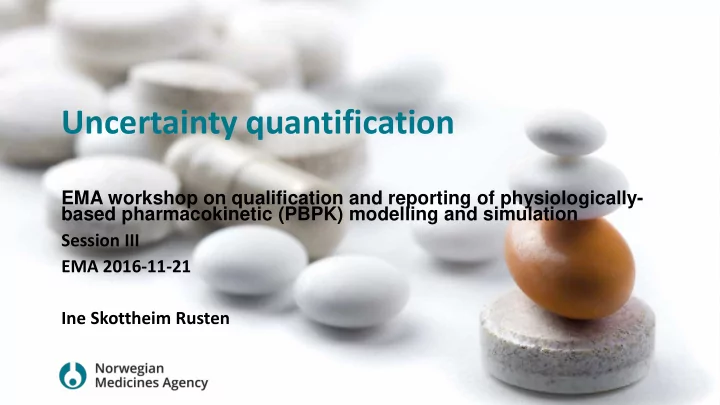

Uncertainty quantification EMA workshop on qualification and reporting of physiologically- based pharmacokinetic (PBPK) modelling and simulation Session III EMA 2016-11-21 Ine Skottheim Rusten
Disclaimer: The views expressed in this presentation are the personal views of the speaker and may not be understood or quoted as being made on behalf of or reflecting the position of the Norwegian Medicines Agency, EMA or one of its committees or working parties.
Uncertainty quantification How do the various sources of uncertainty feed into uncertainty in the model prediction for the outcome(s) of interest? Epistemic Alleatory • reducible uncertainty • variability, stochastic uncertainty or irreducible uncertainty • potential deficiency due to lack of knowledge, can arise from inputs, assumptions, • the physical variability present in the approximations etc system being analysed or its environment • not necessarily well characterized by • normally characterized using probabilistic probabilistic approaches approaches
Aims and approaches Global When to perform? • Based on suspicion – ie lack of fit? Uncertainty analysis Sensitivity analysis Depending on the purpose of use and • the regulatory impact? • As standard? Local • Explore the model properties • Explore the appropriateness of the model • How much do the outcome(s) of interest depend on a spesific parameter or submodel? • How much do the outcome(s) of interest vary according to uncertainty in the parameters, assumptions or other model aspects?
Uncertainty analysis Scenario analysis to identify sources of uncertainty The need depends on the purpose of use and the regulatory impact • relevant for consideration • parameters • assumptions • model structures; ie processes and associated mathematical choices • computational methods, approximations • define the perceived boundaries • of parameters • or alternative setups (processes/mathematical and computational choices)
Case example I - drug model Ibrutinib is an anticancer drug, Sensitivity Analysis on the Effect of I brutinib fu gut on CYP3A4 substrate (minimal 2D6) Sim ulated AUC and C m ax of Oral Single Dose of 1 2 0 m g I brutinib in Healthy Subjects under Fasted Conditions Model: PBPK F u,gut C max (ng/ml) AUC (ng.h/ml) Fg Purpose of use: information in SmPC 0.07 26.9 87.1 0.55 0.09 24.0 78.4 0.50 on CYP3A strong, medium and mild 0.11 21.7 71.4 0.47 inhibition 0.13 19.8 66.7 0.41 0.15 18.3 60.9 0.38 Regulatory impact: high 0.17 17.0 56.8 0.35 Qualification: within procedure Sensitivity Analysis on the Effect of I brutinib fu gut on Sim ulated C max Ratio and AUC ratio of Ketoconazole- UQ: regulatory request for local ibrutinib Drug-drug I nteraction sensitivity analysis based on fitting F u,gut C max ratio AUC ratio characteristics for absorption phase (Substrate) (Substrate) 0.07 14.9 22.5 • absorption parameters 0.09 17.1 25.1 0.11 19.0 27.7 • fugut 0.13 21.0 30.4 0.15 22.9 33.0 0.17 24.2 35.8
Case example I - drug model Ibrutinib is an anticancer drug, CYP3A4 substrate (minimal 2D6) Model: PBPK Table . The effect of reducing the rate of absorption on ibrutinib FG and on the AUC and Cmax ratios obtained upon co-administration with ketoconazole. Purpose of use: information in SmPC on CYP3A strong, medium and mild inhibition Regulatory impact: high Qualification: within procedure NA, not applicable; a geometric mean ratios; b absorption simulated to start in proximal jejunum; c absorption simulated to start in ileum. UQ: regulatory request for local sensitivity analysis based on fitting characteristics for absorption phase • absorption parameters • fugut
Case example II – drug model X is an anticancer drug, CYP3A4 substrate Model: PBPK Purpose of use: inform DDI assessment of TDI and mixed inhibition/induction Regulatory impact: low to moderate Qualification: within procedure (not considered qualified) UQ: AUC • uncertainty analysis • rationale not described • local sensitivity analysis • fa, fugut, Qgut on AUC ratio TDI parameters (KI and kinact) and • induction parameter EC50 on AUC ratio
Case example III - system model X is …, Y substrate Model: PBPK Wish list for the uncertainty analysis Purpose of use: inform paediatric • sensitive parameters dose selection • fraction metabolized Regulatory impact: moderate to high • maturation functions Qualification: within procedure • virtual patient population parameters UQ: for the outcome(s) of interest • other relevant assumptions • uncertainty analysis • … • global sensitivity analysis
Follow us @legemiddelinfo legemiddelverket noma.no
Recommend
More recommend